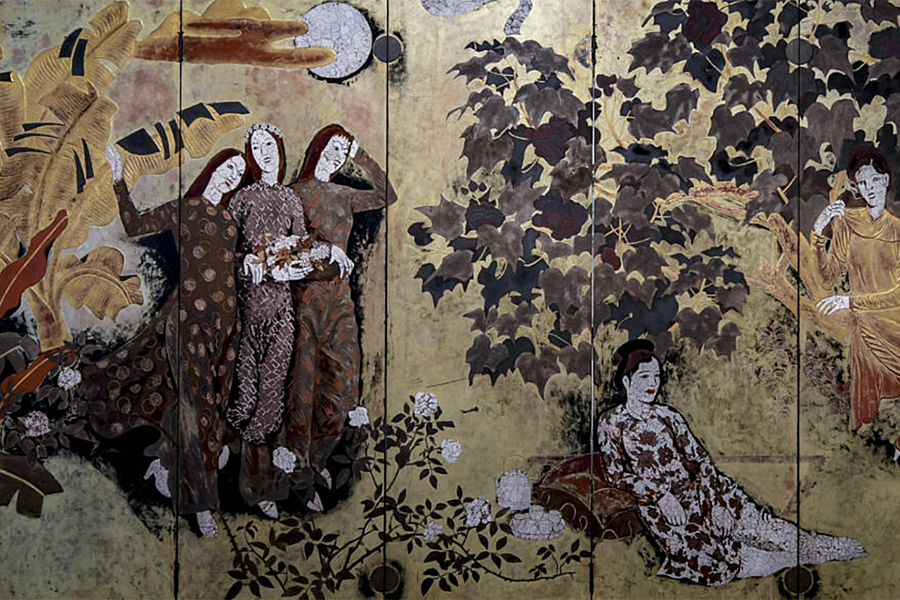Originally used primarily for adorning wooden items, lacquer painting, known as “son mai” in Vietnam, has evolved significantly over the past century. Today, it has emerged as a distinct and celebrated art form within Vietnam, to the extent that it is widely recognized as the nation’s quintessential painting technique. Let’s delve into the fascinating world of lacquer painting and discover the rich history and unique characteristics of this exceptional art form with Hanoi Art Tours.
What is the Vietnamese Lacquer Paintings?
Vietnamese Lacquer Paintings are a captivating and time-honored art form originating from Vietnam. These exquisite works of art are distinguished by their meticulous use of natural lacquer, painstakingly layered and polished to create a lustrous, mirror-like surface. Artists often incorporate additional materials like crushed eggshells, metallic leaf, or mother-of-pearl to add texture and depth, resulting in visually stunning and tactile masterpieces. These paintings can encompass a diverse range of subjects, from traditional landscapes and cultural motifs to abstract and contemporary expressions. Rooted in a history that spans over a millennium, Vietnamese Lacquer Paintings blend Chinese influences with a distinctly Vietnamese aesthetic, making them both culturally significant and highly regarded in the realm of fine art.
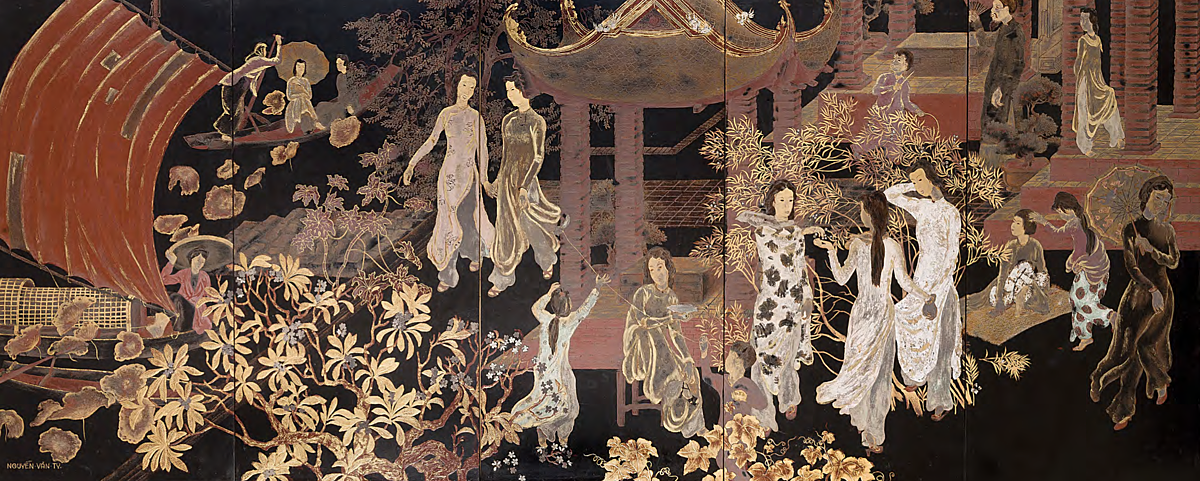
For foreign tourists visiting Hanoi, Vietnamese Lacquer Paintings offer a unique and captivating window into the rich cultural heritage of Vietnam. These remarkable artworks, with their glossy and intricate surfaces, are a testament to the country’s artistic traditions and craftsmanship. Hanoi, in particular, is a hub for experiencing the beauty of Vietnamese lacquer art, with numerous galleries and studios showcasing both traditional and contemporary pieces. Whether depicting the serene landscapes of Vietnam’s countryside, showcasing traditional motifs, or exploring modern artistic concepts, these lacquer paintings tell stories that resonate with the soul of the nation. For tourists, they serve as a meaningful and portable memento of their visit, encapsulating the essence of Vietnam’s artistic expression and culture, making them a cherished keepsake of their time in Hanoi.
The Materials Used in Vietnamese Lacquer Paintings
Vietnamese lacquer paintings are renowned for their intricate and labor-intensive techniques, and they involve a variety of materials to achieve their stunning effects. For travelers curious about the intricate art of Vietnamese Lacquer Paintings, these exquisite creations rely on a range of fascinating materials. Here are some of the primary materials used in the creation of Vietnamese lacquer paintings:
Lacquer: The most essential material is natural lacquer, obtained from the sap of the lacquer tree (Rhus vernicifera). This resin is the foundation of the artwork and is applied in multiple layers . Each layer is meticulously applied and polished to create the signature glossy and durable surface of Vietnamese lacquer paintings.
Wooden Base: Typically, a wooden panel or frame serves as the base for a Vietnamese lacquer painting. The choice of wood can impact the final appearance and stability of the artwork.
Pigments: Pigments are used to create the colors in the Vietnamese Lacquer Paintings. Traditional pigments are often mineral-based and mixed with lacquer to create various shades and hues. Modern lacquer artists may also use acrylic or oil-based pigments for certain effects.
Eggshells: Crushed eggshells are a common additive in Vietnamese lacquer paintings. They are sprinkled onto the wet lacquer to create texture and add depth to the artwork.
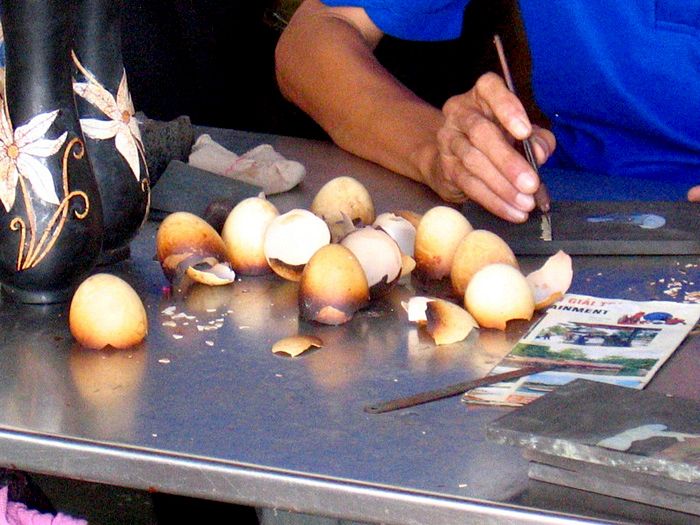
Metallic Leaf: Silver or gold leaf is sometimes used to highlight specific areas or create shimmering effects in the Vietnamese Lacquer Paintings. The leaf is carefully applied and adhered to the lacquer surface.
Mother-of-Pearl: Thin slices of mother-of-pearl shells can be inlaid into the lacquer to create intricate patterns and details. This technique is often used for highlighting and creating contrasts in Vietnamese Lacquer Paintings
Natural Dyes: Artists may use natural dyes derived from plants, flowers, or other organic sources to achieve specific colors and tones in painting.
Tools: Various tools such as brushes, spatulas, and knives are employed for applying and manipulating the lacquer and other materials. These tools are crucial for achieving the desired texture and detailing.
Polishing Materials: The final polishing process is a critical step in creating the glossy surface of Vietnamese lacquer paintings. Artists use fine sandpaper, powdered charcoal, or even the cuttlefish bone to achieve the desired level of smoothness and shine.
Protective Layers: Clear lacquer is often applied as a protective layer over the finished artwork to preserve its longevity and luster.
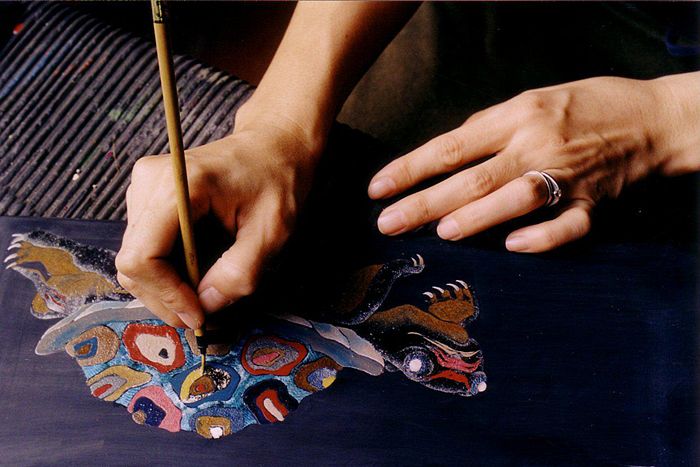
These materials, combined with the skilled craftsmanship of Vietnamese artists, contribute to the distinctive and visually captivating nature of Vietnamese lacquer paintings, making them a cherished part of the country’s artistic heritage. Perfect for travelers seeking a unique and meaningful souvenir.
How to Make a Vietnamese Lacquer Painting
Creating a Vietnamese lacquer painting is a complex and time-intensive process that requires skill, precision, and a deep appreciation for this traditional art form. Here’s a step-by-step guide on how to make a Vietnamese lacquer painting:
Preparing the Wooden Base
Start with a wooden panel or frame, traditionally made from indigenous woods like jackfruit or bamboo. The choice of wood can influence the final appearance and durability of the painting. Sand the wooden surface to ensure it is smooth and free of imperfections.
Applying the Base Layer of Lacquer
Apply a base layer of natural lacquer to the wooden surface. This layer serves as a foundation for the artwork and helps seal the wood.
Design and Composition
Sketch or draw your intended design onto the lacquered surface using charcoal or pencils. Plan the composition carefully, considering the use of color, texture, and any optional materials like crushed eggshells or metallic leaves.
Layering and Polishing
Begin applying multiple layers of lacquer, allowing each layer to dry thoroughly before adding the next. The number of layers can vary but typically ranges from 10 to 20 or more. In between layers, sand and polish the surface with fine sandpaper and powdered charcoal. This step is critical for achieving the signature glossy finish of lacquer paintings.
Incorporating Optional Materials
If your design includes elements like crushed eggshells, silver or gold leaf, mother-of-pearl, or natural dyes, apply them in the appropriate places on the painting. These materials can add texture, depth, and luster.
Fine Detailing
Use brushes and other tools to add fine details, highlights, and shading to your artwork. Vietnamese lacquer paintings often feature intricate and meticulous detailing.
Final Polishing
After completing the painting and ensuring all layers are perfectly smooth and glossy, give it a final polish to achieve the desired shine.
Clear Lacquer Finish
Apply a clear lacquer layer as a finishing touch to protect the painting and enhance its longevity. This layer adds a final level of gloss and acts as a protective seal.
Drying and Curing
Allow the completed artwork to dry and cure in a well-ventilated area for an extended period, which can range from several weeks to several months depending on the size and complexity of the painting.
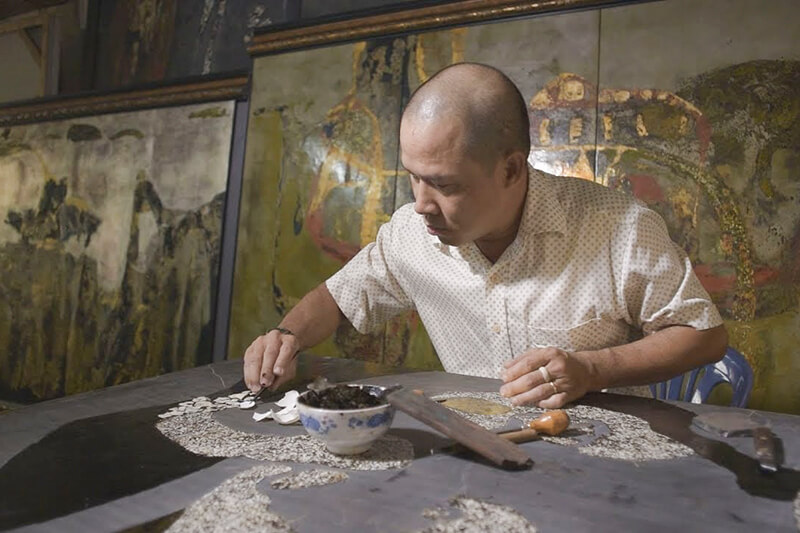 The Process Of Making Lacquer Paintings in Vietnam Fine Art (Source: Nguyen Art Gallery)
The Process Of Making Lacquer Paintings in Vietnam Fine Art (Source: Nguyen Art Gallery)
Creating a Vietnamese lacquer painting is a labor-intensive process that demands both artistic talent and technical expertise. The result is a breathtaking piece of art that showcases the unique beauty and cultural significance of this traditional Vietnamese craft.
Notable Vietnamese Lacquer painting artists and their contributions
While Vietnamese lacquer paintings themselves are the stars of an art tour, it can be informative and engaging to discuss some of the notable artists who have contributed significantly to the development of this art form. Here are a few famous Vietnamese lacquer painters whose work and contributions you can introduce during our art tour
.jpg?mode=max)
Nguyen Gia Tri – Father of Modern Vietnamese Lacquer Painting
Known as the “Father of Modern Vietnamese Lacquer Painting” Nguyen Gia Tri played a pivotal role in revitalizing and modernizing this traditional art form. His innovative techniques and use of colors continue to inspire contemporary lacquer artists.
Trinh Tuan
Trinh Tuan is celebrated for his lacquer paintings inspired by the classic Vietnamese epic “The Tale of Kieu.” His meticulous attention to detail and storytelling ability have made his work both culturally significant and artistically renowned.
Nguyen Van Tuan
Nguyen Van Tuan is recognized for his contemporary approach to lacquer painting. “The Golden Lotus,” one of his notable works, blends traditional techniques with a modern aesthetic, incorporating gold leaf to stunning effect.
Dinh Quan
Dinh Quan’s work often focuses on landscapes, particularly the Red River Delta region of Vietnam. His use of color and layering techniques captures the essence of Vietnam’s countryside and its historical significance.
Le Cong Thanh
Le Cong Thanh’s series of lacquer paintings titled “The Divine Moments” explore themes of spirituality and meditation. His work is known for its intricate details and serene compositions that evoke a sense of inner peace.
Bui Huu Hung
Bui Huu Hung’s “Cyclo Series” presents a contemporary perspective on urban life in Vietnam, with the cyclo as a central motif. His paintings explore the juxtaposition of tradition and modernity in Vietnamese society.
Le Dinh Quy
Le Dinh Quy’s paintings often celebrate traditional craftsmanship in Vietnam, with a focus on artisans engaged in pottery and silk weaving. His meticulous attention to detail highlights the skill and beauty of these crafts.
During our art tour, Hanoi Art Tours shares insights about each artist’s background, artistic influences, and the key themes or techniques they are known for. Discuss how these artists have contributed to the evolution and recognition of Vietnamese lacquer painting as a unique and cherished form of artistic expression. Additionally, showcasing examples of their work allows tour participants to appreciate their contributions firsthand.

